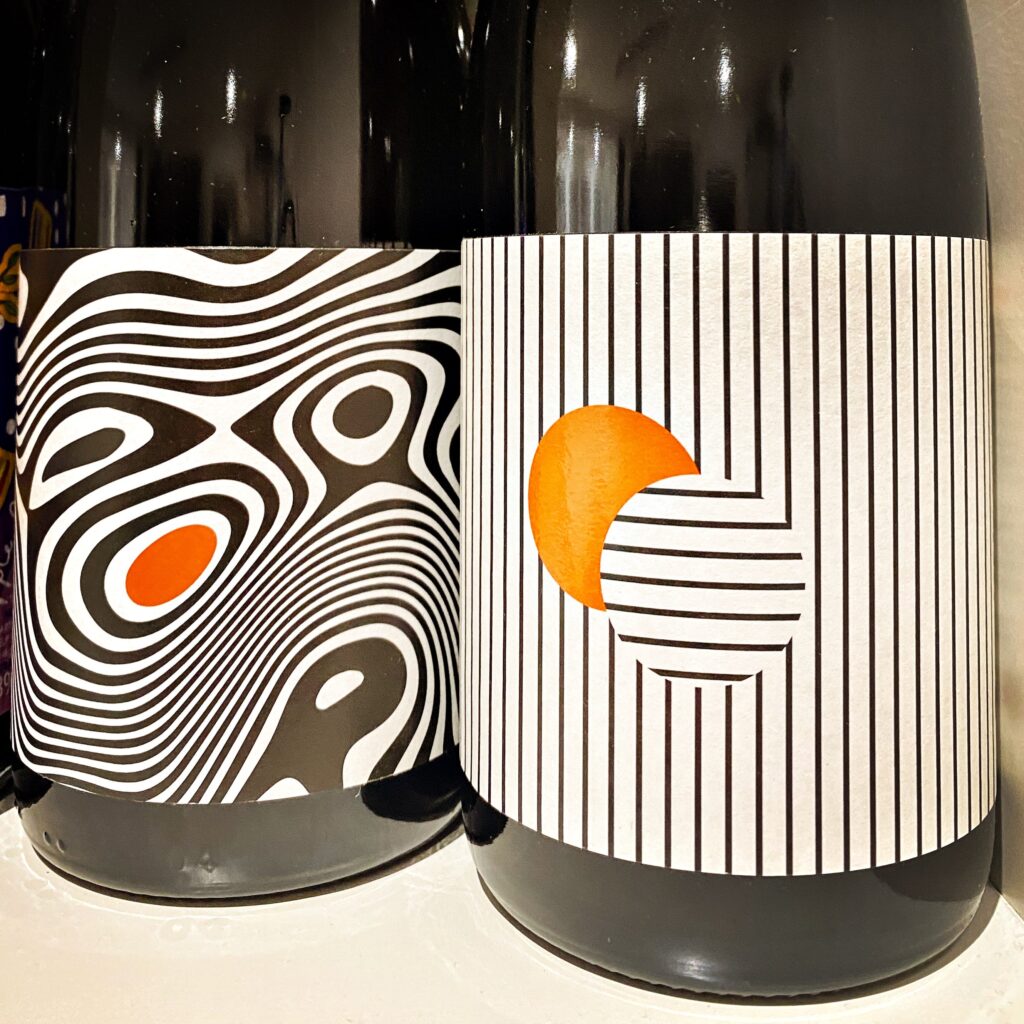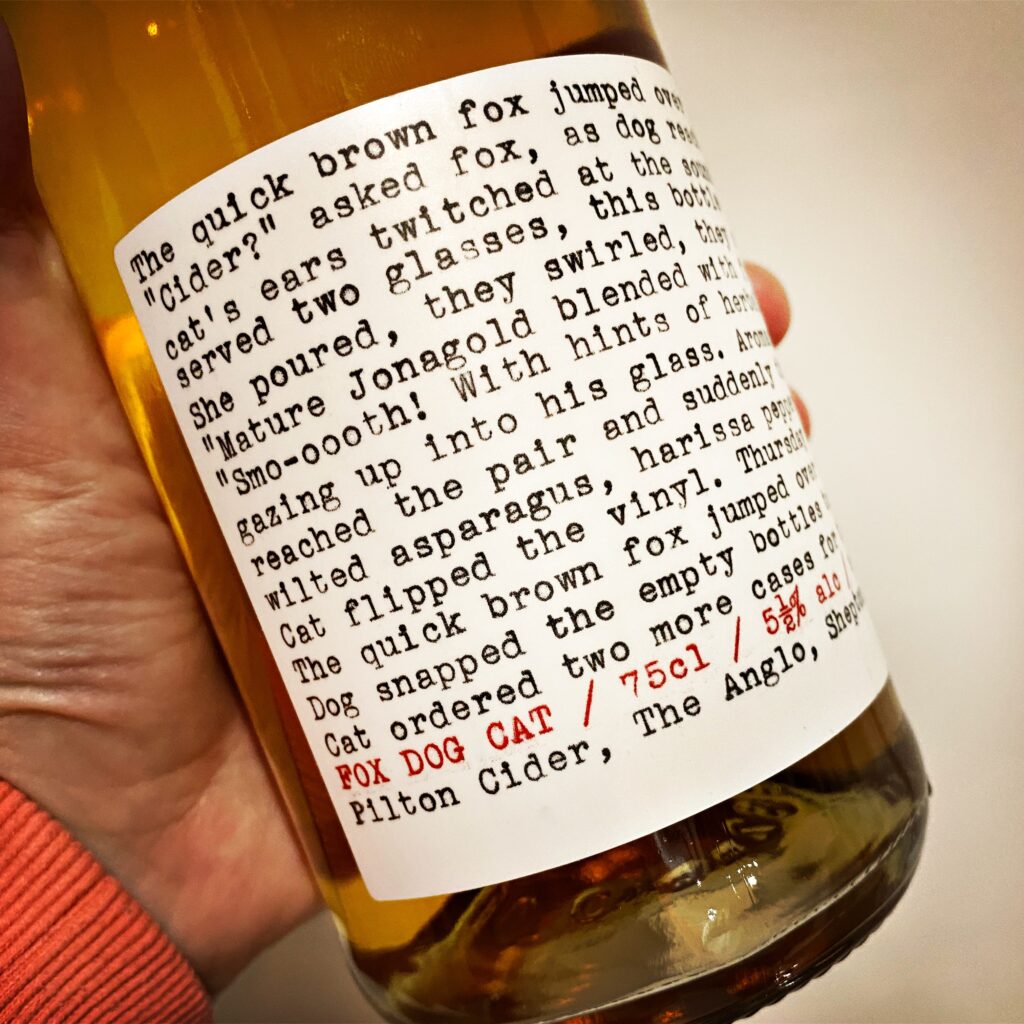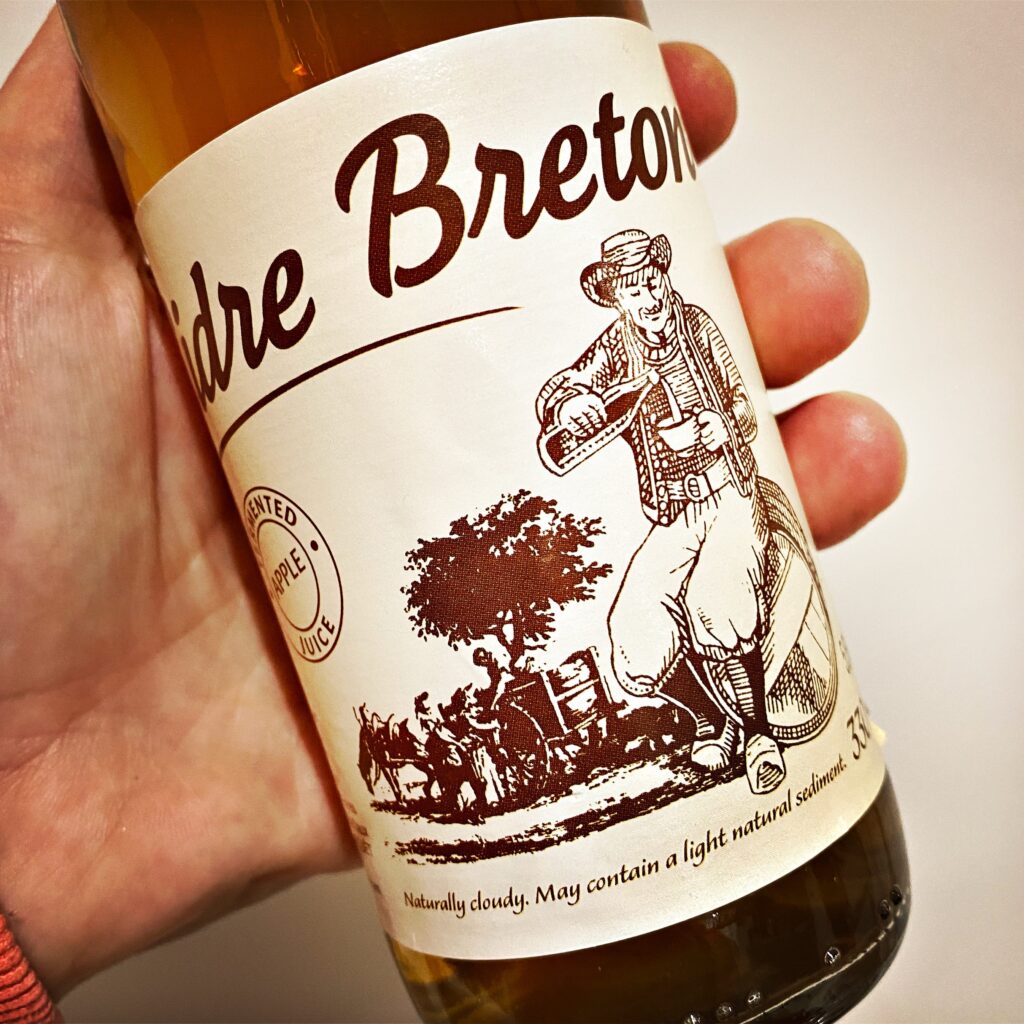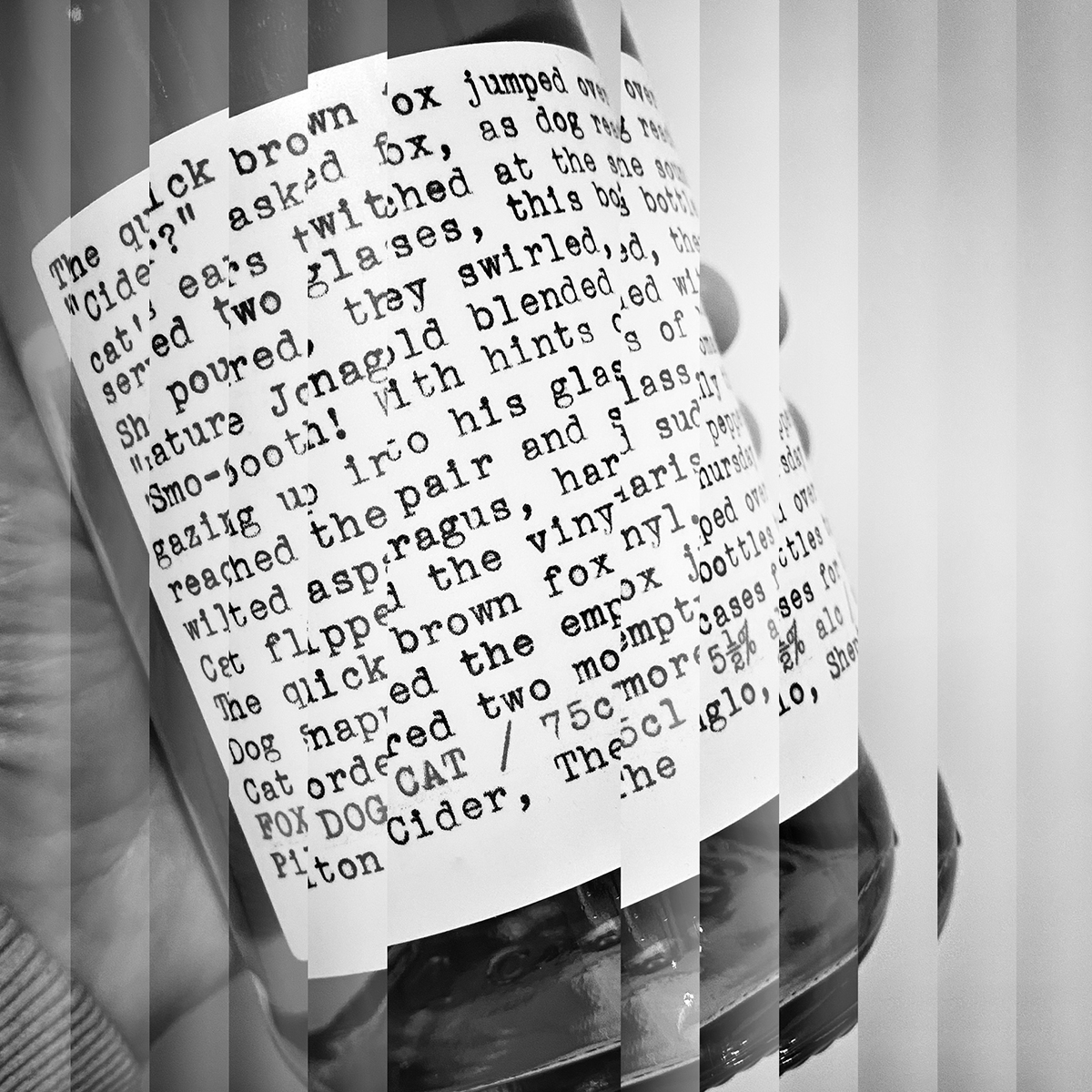A Communiqué featuring Irish harps, Italian typewriters, and fast German cars – let’s talk labels for a moment, shall we?
New and established craft beverage producers have a tough job ahead of them if they want to convince us, the consumers and drinkers, to buy their product. Shelves are now filled with brightly coloured, sometimes tactile, sometimes monochrome, loud, persuasive, or simple labels – all trying to compete for consumer attention, to invite impulse purchases based simply on the information printed on those little spaces. I, for one, have bought bottles and cans because of how attractive the labels were. Labels have become more than a straightforward advertising space for the brewer or maker of the drink. Well-designed labels not only tell the brand’s story, they grab consumers by the labels and demand they spend their money on them. Labels are the visual identity of a brand and as such, can be as important as the liquid inside the bottle / can they are attached to.
According to an article in The Drinks Business[i], us Brits voted with our £££s for San Miguel, Guinness and Heineken as our top three beer brands respectively, in the first quarter of 2022. By the time the last quarter rolled around, Guinness had climbed to the top spot, followed by Stella Artois and Peroni[ii]. One could therefore argue, if so inclined, that the Guinness harp is one of the UK’s most recognised alcoholic brand symbols.
Those clever marketing peeps back in the 1860s, knew exactly why they wanted the harp associated with their stout: not only is the harp the national symbol of Ireland – check the cover of an Irish passport, or an Irish minted €uro coin -, it’s connotations invoke Irish culture and heritage, and most importantly a good time, or more appropriately phrased, the craic. Guinness even trademarked the harp in 1876, which means that the Guinness harp faces one way, while the government harp must face the other. Useless trivia or pub quiz gold, you decide.

Hold up, back up, craft beverage producers? Yes, you read correctly I am going there (again…) and this time I’m considering the term from a slightly different angle, not specifically looking at the liquid in the bottles and cans but looking at its packing and how this may/will influence consumers.
Craft, as defined by Oxford Languages and Google is “an activity involving skill in making things by hand”[iii], followed by indicating that activity, occupation, calling, skill and walk of life, to name a few, are words with similar meaning. I love the concept of craft meaning walk of life: Well, yes good sir, my walk of life involves brewing beer by hand indeed!
One sentence that encapsulates the mood surrounding the seemingly never-ending conversations regarding the definition of craft was written by Pete Brown in 2020. Those 14 words describe so perfectly why we seem to struggle to define craft, and how we tend to rely on tradition more than some craft producer may wish to accept, while boosting the futuristic notions of our actions:
“If cask ale hadn’t existed before now, it would be a hipster’s wet dream.”[iv]
And yeah, this sums it all up, doesn’t it? Cask ale fulfils the notion of craft. Craft seems to mean the idea of creation by humans, other than mass-produced machine-made beer.
In the beer world, craft seems to be seen as something new, opposed to something more traditional, and by association, old: the classic Craft Beer VS Traditional Beer approach: Craft Lager vs Czech Pilsner, East Coast IPA vs English IPA.
In cider circles, this notion seems to run into something vaguer and squishier – craft, artisan, traditional, farmhouse, boutique … overall, cider seems to still occupy a more juvenile, still less fully fledged, constructed space in our heads, akin to craft beer in the 90s. Definitions of whether craft cider is indeed craft or not, has still a long way to go.
Nevertheless, this appears to be more of an academic approach to defining a product or even the act of production overall. Is it the way the stuff is served to us? Would the proper way of pouring a Guinness be craft? Cask ales may indeed be brewed on lager scale, without too much human intervention. And let’s not forget that the yeast is the actual star in live cask beer. Should we therefore attach labels to the single-celled microorganisms involved, rather than the overall finished product?
“Brewed by humans, fermented by craft yeast”
Westons Cider Report 2022 segments commercially available ciders as Crafted (e.g Henry Westons Cloudy Vintage Cider, 7.3% ABV), Mainstream (e.g., Strongbow, 5% ABV), Premium (such as Bulmers, 4.5% ABV and Koppaberg, 4-4.5% ABV ciders), Value Amber (e.g., Blackthorn Cider, 7.5% ABV) and Value White (such as Omega White Cider, 7.5% ABV)[v]. Unfortunately, the ’22 report neglects to offer definitions of the terms they use, and so I can only assume they somehow assigned those categories arbitrary based perhaps on market value? Do let me know if I missed the definitions somehow and I will be happy to look further into this.
In the ‘23 report, Crafted actually gets more detailed mentions, stating that this part of the UK cider market achieved the biggest growth, due consumer desires to “drink less but better”[vi] .
In addition, the report elaborates further “[…] Crafted has a higher average price than total cider and consists of traditional and heritage products. […]”[vii]
Here, craft is seen as equal to heritage and tradition, regardless (or so it seems) of the size of the producer or their annual output. The way the liquid is produced, ahem, crafted, is the driving force.
This definition of craft(ed) cider sits alongside various other opinions and highlights just how hazy and vague the notion of craft has actually become. Craft, as an activity, is often lumped with art and design, a concept which leaves a bitter taste (yup, I went there). Yet, all three activities are separate entities. Craft in itself is vast, why group it with other equally vast occupations and skill sets? But I digress…
In 2019, Bryce Eddings defines craft beer as “[…] a beer that is not brewed by one of the big “mega-brewery” corporations. […]”[viii] Here, it seems size, annual output and definition of ownership appears more important.
The Brewer’s Association offers the following concept: “[…] Craft beer is generally made with traditional ingredients like malted barley; interesting and sometimes non-traditional ingredients are often added for distinctiveness […]”[ix] We’re back flirting with tradition…
We love to drink craft, but can we agree on a definition? Or is the very notion of craft as concept unagreeable and thereby self-fulfilling?
Like the outcome of my first ever brewing experience, a traditional bitter made the craft beer way, many beers, ciders and indeed wines exist beyond randomly attached labels and definitions. Yet, consumers love to debate, me included – no shame here.
Aligning oneself with a group’s ideas helps us feel part of a great community, a belonging to society. We are not alone in accepting something as the truth. Are you Team Craft or Team Traditional? Or perhaps Team Traditional Craft? Or maybe… you get the point.

Happily, craft cider inhabits a less crowded, and perhaps less definition-loaded, space than craft beer. Walk into any standard bottle shop and you’ll likely find ciders stacked somewhere in the corner, perhaps next to the sour and wild fermented beers. Or, maybe they have found their home next to the wines… You may even have to ask where you can find the fermented apple, which is problematic in itself, but presents on the flipside a less competitive market space. With less labels shouting at you for attention, you may be able to give each one the time it deserves.
Labels are a funny thing, aren’t they? Some people collect them, others pay no mind to them at all, some are works of art, and some, … well… are not.
If we agree that the basic idea of a label is to convey the name of the product, the producer and how potent the liquid is in terms of ABVs, then we could also agree that those personal little spaces on cans and bottles should be treated accordingly. Show us what you’re all about – give us effective labels!
One of my most prized possessions is a red typewriter designed by Ettore Sottsass and Perry King for Olivetti in 1968. The Valentine is unmistakably Sottsass, it’s bright and loud, sexy and functional, clever and subtle, yet it never really made it commercially… it unquestionably made its way into the hearts of consumers and contemporary designers alike, and it certainly became the talk of the season. From a design thinking perspective, it won gold over and over, but in moneymaking terms it went nowhere really. Even Sottsass himself became disillusioned but his own creation, as he “[…] felt that he had become known solely for this “red machine” that “came out a mistake. […]”[x] Nonetheless, or maybe because of exactly this, I was drawn to this little red plastic typewriter from the moment I saw it. Is it the name? The designer’s reputation? The colour? The space it occupies artistically, socially, technically? Well, honestly, I don’t know. It just works for me, without trying too much, it persuades me that I need to get my paws on it.
And that’s what I mean when I say “effective labels” – I want to be lulled into buying the product.
One of my favourite labels in the current craft cider world is attached to Pilton’s Fox Dog Cat (5.5% ABV) bottle. Incidentally, if the husband and I had a house style cider, it would be Fox Dog Cat, because it is just so so good….
Described on the website as “[…] [a] text-only label […] created on a 1935 typewriter”[xi] it ticks all the boxes on the long list to my heart, not only because it indulges my typewriter fantasy. The label tells, quite literally, a story: the story of three animals enjoying some cider. But, it also tells me more than that: typewritten words convey a more hands on approach. Having written half my notes for my undergraduate dissertation on a typewriter, I am aware of how physical writing on a typewriter is. Its tactile and somewhat more craft than writing words which appear on a screen, or at least it appears to be.
In addition, the labels suggest a nod to history and artisanship, as well as simply being fun – and if Pilton is anything, then it’s fun cider.
But, is it effective? Well, that depends on where you stand:

Does it tell you who the producer is? Yes. Does it state the name and ABV of the liquid? Yup. Does it tell you what the bottle contains in great detail? Not really. Does it need to? Does it convince you to buy it? Should the label tell the consumer where the liquid originated?
Let’s drift into the wine world for a second (I know I know……) and how certain wines come almost pre-loaded with appreciation. Imagine a bottle of Burgundy or Bordeaux. Even to the uninitiated, i.e., me, those two words convey so much more than simply wine. The mind jumps immediately to terroir (= taste of place), and because we’re talking French wine, terroir is simply accepted. No questions asked. Even the Italians use the term to describe wine’s unique taste and quality, and that says something, doesn’t it?!
When it comes to wine, labels offer all the information one could possibly ever need: the name and address of the supplier or the bottler of the wine, the country, or countries of origin, the ABV, the vineyard, grape variety, the vintage, sulphite content, inside leg measurement of wine grower, you name it.
The label on Fox Dog Cat, as mentioned, states the name of the cider, the ABV, the vintage, name and address of the cider maker, as well as sulphite content. Does it look craft? Well, yes it does. It allures a handmade quality, something the maker has spent time with, other than a mass-produced beverage.
But why? you may ask, and rightly so. Does it tell you the hours the cider maker has spent hand picking the apples? Does it offer any clues into the orcharding practices perhaps? Does it tell you what apples have gone into the cider or how it was made? Go as far as mentioning that cider has/ can have (delete as appropriate) terroir seems to cause a variety of responses, including acceptance, ignorance, ridicule and apathy, amongst others.
Yet, a place-based identity is just as appropriate to cider as it is to wine. And, even beer, although, here we enter more murky waters… but land-taste still persists.
Terroir seems to lend itself to craft and tradition like an Ice Cider to Carrot Cake, Barolo to dry-aged steak or Brown Ale to Roquefort. That is, if you prescribe to the notion of “land-taste” – marketing tool or reality? You be the judge.
To bring the point home, Fox Dog Cat hails from Somerset[xii], a county in South West England, which is famed around the world (cough cough) for its ciders, by those who sing its praises.
The tension becomes almost unbearable now: is craft the liquid within the bottle or the label on it? Is craft equal to tradition, is craft inspired by tradition or is craft a break from tradition?
Let’s not forget the cries of “Sell Out!!” in 2011 when Goose Island was acquired by A-B InBev and Camden Town Brewery becoming part of said brewing conglomerate in 2015, or Heineken purchasing Beavertown in 2018, which indicate that the size and (global) market reach of the producer plays a key part in defining craft.
I think now is the point where I’ll leave attempts to define craft for the time being and redirect myself back to the drink’s labels.
Apart from Fox Dog Cat, another fantastic label is attached to bottles of Cidre Breton Brut Traditionnel (5% ABV). I like its simplicity, it doesn’t shout great cider at you in bold letters or bright colour. It doesn’t have to. It is not intended to compete with other more craft-inspired ciders. It simply exists as an option on the shelf. It is an everyday drink, to be enjoyed regularly. The label depicts exactly that: a traditional scene of cider making in rural France. The perfect label for a traditional Brittany Cidre. The label convinces you, that the liquid inside ought to be good based on the accepted ideas of traditional craftmanship.

Upfront Brewing’s label for Das ist Techno Sex[xiii] (5.4% ABV) is equally simplistic in style yet shouts much much louder: a can which satisfies anyone’s vivid technicoloured dream, by serving nothing but chromatic futuristic sci-fi brightness, underlined by simply the name of the beer.
Here, the label mirrors the liquid inside: a key lime Gose, with a kiss of Himalayan salt, coriander and Citra. If reading the citrussy description makes your mouth water, you’re not alone: the beer shouts a kaleidoscope of flavours at you – all coexisting and competing, yet coming together in the end. Just like it’s label.
On a side note, Das ist Techno Sex actually holds a particular place in my heart: it’s the craft beer that started it all for me – the beer that introduced me to the notion of craft beer. It obviously had to be a German style, come on, don’t even go there.
Before sipping this multicoloured example of flavours and aromas, I was happily drinking English bitters, Czech pilsners, Belgian ales and German Weizen without dissecting their origins. I simply drank beer. I simply enjoyed beer. I simply didn’t feel the need to dig deeper.
And then, all of a sudden, I found myself in this new world of extreme acidity, bitterness and sweetness, Kettle Sours, TIPAs, Imperial Stouts. And just like that I now drink craft beers, traditional ales: small scale offerings and large-scale brews – beer became much more scholarly. A bitter-sweet moment indeed, but back to the labels:
Three very different labels, three very different liquids inside. Yet all three labels convey the message the liquid is trying to send:
Fox Dog Cat invites you to a cosy afternoon, layered with sweet and deep conversations, or indeed fruity and fun games. Cidre Breton Brut Traditionnel requests nothing of you, but offers simple refreshment, an enjoyment of terroir – a familiar hug from tradition. Das ist Techno Sex demands you pay attention, it is bold, loud and fast, yet somehow organised and questionably law-abiding – like that superfast silver Benz you only notice last minute in your rear-view mirror while trying to overtake a lorry on the Autobahn, flashing its headlights in common understanding that you let it fly past before you make a move.
And there you have it: Each label gives the consumer a glimpse into the promised flavour experience. They work: they are effective, crafty, and traditional. Little windows into the experiences promised by the drink. They may only be a small piece of paper, fabric, plastic, or similar material attached to an object, giving information about it, but they are as significant as the liquid inside, regardless of craft(ed) status.
Now do excuse me while I head to the shops to peruse some labels on the shelf.
Good day
xxx
[i] The Drinks Business. The 10 most popular beer brands in the UK. By Louis Thomas, published 05 July 2022 https://www.thedrinksbusiness.com/2022/07/the-10-most-popular-beer-brands-in-the-uk/ [Accessed 30/03/23]
[ii] YouGov The Most Popular Beer & Cider Brands (Q4 2022) https://yougov.co.uk/ratings/consumer/popularity/beer-cider/all [Accessed 30/03/23]
[iii]Dictionary craft https://www.google.com/search?client=firefox-b-d&q=defititon+craft [Accessed 29/03/23]
[iv] Brown, Pete (2020) Craft: An Argument: Why the term ‘Craft Beer’ is completely undefinable, hopelessly misunderstood and absolutely essential.
[v] Westons Cider Report 2022, page 27
[vi] Westons Cider Report 2023, page 9
[vii] Ibid., page 28
[viii] The Spruce Eats. A Working Definition of Craft Beer. By Bryce Eddings. Updated 21/05/2019 https://www.thespruceeats.com/craft-beer-definition-353250 [Accessed 31/03/23]
[ix] Brewers Association for Small & Independent Craft Brewers Craft Brewer Definition https://www.brewersassociation.org/statistics-and-data/craft-brewer-definition/ [Accessed 31/03/23]
[x] Valentine Portable Typewriter, The Metropolitan Museum of Art https://www.metmuseum.org/art/collection/search/739409 [Accessed 29/03/23]
[xi] Fox Dog Cat, Pilton Cider https://www.piltoncider.com/products/foxdogcat [Accessed 29/03/23]
[xii] Visit Somerset, Somerset Food, Drink & More!https://www.visitsomerset.co.uk/things-to-do/food-drink-more/made-in-somerset [Accessed 29/03/23]
[xiii] Das ist Techno Sex, Upfront Brewing http://www.upfrontbrewing.com/shop/8uxlsnaosakrfdt2ealrfhffinepoi [Accessed 29/03/23]

Leave a Reply